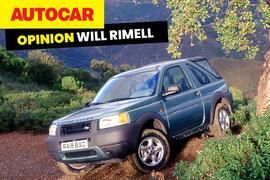 The P38 Range Rover and Mk1 Freelander are worthy of more respect - reliability issues aside
The P38 Range Rover and Mk1 Freelander are worthy of more respect - reliability issues aside
I’m quite a patriotic person, the type who will watch any sporting engagement whatsoever with an English representative.
That also translates into the automotive sphere, which is why I have such a deep-seated affinity for Land Rover.
I especially appreciate the earliest examples for their unassuming badassery. Take the Series 1: it may look rudimentary by today’s standards, but its compact proportions and innovative four-wheel drive system mean it can tackle unforgiving terrain as capably as a new hatchback handles the M25.
Plus, there’s undeniably a certain beauty in its raw, function-over-form design. And yes, it’s objectively terrible to drive, and the cabin has all the suppleness of a park bench, but you can’t have it all.
This boxy aluminium workhorse was the genesis for everything that Land Rover has put its name to over the past 77 years, including the Range Rover, the Discovery and the mega-popular modern Defender to which it serves as an indirect forefather.
Most poignantly to me, though (and perhaps uniquely), the expansion of the Land Rover family would ultimately lead us to the oft-overlooked Freelander.
I first fell for Landies when I was around 10 years old. My mum had this beautiful dark green Mk1 Freelander as our family runaround. I couldn’t tell you the engine or the spec, but I remember just being completely and utterly in love with it.
This was back when do-it-all family crossovers could still exude real kerb appeal and genuine charisma, and to a car-mad kid, its chunky, purposeful proportions were bang on. The side-hinged boot with its lowering rear window still feels novel and fun even two decades later, too.
Sadly, it went after a few years, replaced by a comparatively humdrum Chrysler Voyager after one too many wallet-busting repair jobs.
At the time, I didn’t understand the decision: why swap from a lovely British 4x4 to a drab, amorphous American people carrier? The Freelander’s well-documented reliability issues didn’t really register on my juvenile radar.
But that wasn’t the end of my family’s Land Rover story: fast forward just a few years and I was waiting for a lift after school when around the corner hummed a P38A-generation Range Rover, and behind the wheel of this regal runaround, much to my surprise, was my dad, looking a bit miffed.
He had been forced to buy it after my mum discovered eBay and wanted something with a towbar.
I couldn’t understand how a man so cosily enveloped in such a sumptuous, full-brown leather interior could look so miserable. Until I clocked that it was leaning quite obviously to one side and was powered by the notorious 4.0-litre petrol V8. Poor man.
But the Rangie’s quirks – even its failed air suspension (which never got fixed) and low-double-digit MPG figures – just made me love it even more.
Even though it shared space with an MGF, that 4x4 was the best thing we ever had on the driveway.